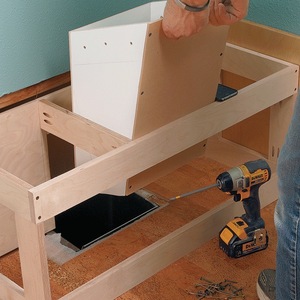My ground floor has 2×8 floor joists. Remodeling the basement means raising the forced air ducts in the basement ceiling a few inches. I’m thinking I can cut a notch into the floor joists, the width of the air ducts (24 inches) and perhaps 3 inches deep, and reinforce the joists by sistering with a 2×4 on each side of the 2×8. Bad idea? If not, how long should the 2×4’s extend beyond the notches?
Discussion Forum
Discussion Forum
Up Next
Video Shorts
Featured Story

Learn more about the benefits and compliance details for the DOE's new water heater energy-efficiency standards.
Featured Video
How to Install Cable Rail Around Wood-Post CornersHighlights
"I have learned so much thanks to the searchable articles on the FHB website. I can confidently say that I expect to be a life-long subscriber." - M.K.

















Replies
The top 4.5" of the joist, 7.5" joist minus 3" notch, with a 2x4 of the same material characteristics on each side, will have 80% of the strength and 42% of the stiffness of the original joist. That's just for the extent of the notch, of course. I don't have the tools to tell you how that would affect the performance of the whole joist.
If you cut the sisters out of 2x6's, to make them the full 4.5" depth, you'd get 108% of the strenght of the original joist, but still only 66% of the stiffness.
If you put two 4.5" deep sisters on each side, you can match both the strength and stiffness of the original joist.
Another possibility would be steel mending plates. I don't have any anformation on how to size those.
If you go with wood, I'd extend the sisters at least 3' on each side of the notch, or to the end of the joist if the notch is that close to the end. Make sure they are rigidly attached, glued and screwed with a non-creeping adhesive.
thanks, uncle dunc - I knew someone would help me out!
Removing the bottom 40% of a floor joist does not sound like a good idea.
Whenever you are asked if you can do a job, tell'em "Certainly, I can!" Then get busy and find out how to do it. T. Roosevelt
I'm not sure that Dunc gave you any advice really. He stated thqt removing the material woiuld take away a percentage of its strength.
The rules are that NO, you nerver notch any amt from the bottom of a floor joist. You will have serious problems if you do.
Welcome to the
Taunton University of Knowledge FHB Campus at Breaktime.
where ...
Excellence is its own reward!
>> I'm not sure that Dunc gave you any advice really.Well, I intended to, really. I advised him that there is a way to patch the notched joists that will bring them back up to or above their original strength and stiffness values. Do you disagree?
Well Dunc, do you suppose that a 2x8 floor joist has the same stength as a 8x2 joist? Cuz what you're suggesting is that he regain the strength by making the joist wider, not deeper.
Whenever you are asked if you can do a job, tell'em "Certainly, I can!" Then get busy and find out how to do it. T. Roosevelt
I can see there's some stong opinions here, which is great, that's what this forum is for, and I'm gonna have to take a lot into consideration. Sounds like I might want to look into steel as a support before I go any further, see if that's an option at all.
This is not just a simple matter of opion, strong or otherwise. It is a definite code matter. The codes do no allow notching the bottoms of joists. The only way around that simple fact is to have a qualified engineer visit the site and design a solution for you. Dunc has mentioned a scenario, but he is still working in theory without seeing al the facts of the site re: bearing points, spans, etc.
and an engineer on site may find a way to do it cheaper too.
Welcome to the Taunton University of Knowledge FHB Campus at Breaktime. where ... Excellence is its own reward!
You're certainly right about the code. If I were contemplating such a project I'd be very careful not to attract the building inspector's attention.
Or to dis tract his attention with papers from the engineer.
Welcome to the Taunton University of Knowledge FHB Campus at Breaktime. where ... Excellence is its own reward!
No, but I do suppose that a joist 7.5" wide by 4.5" deep is just as stiff as a 2x8 and quite a bit stronger.The stiffness of a solid wood joist varies as the cube of the depth. 4.5" is 60% of 7.5", so the stiffness of a 1.5" wide by 4.5" deep joist is 0.6 cubed, or 21.6% of the stiffness of the full 2x8. The strength of a solid wood joist varies as the square of the depth, so the strength of a 1.5" x 4.5" joist is 0.6 squared, or 36% of the strength of a 2x8.The strength and stiffness of a solid wood joist both vary directly with width. Twice as wide equals twice as strong and twice as stiff. So if I laminate five 1.5" x 4.5" boards together, I get a joist 7.5" wide and 4.5" deep with 5 x 21.6% = 108% of the stiffness and 5 x 36% = 180% of the strength of the original 2x8.Do you disagree?
I agree that it is possible, with careful engineering to achieve the replacement strength. In your fist post, you rambled over several different options which didn't seem as conclusive as in the latter post.But what I would disagree with is the practicality of sistering four of five pieces of lumber to the original and doing it in a way that acheives the design intent. one also now needs to account for the fact that the dead load has increased significantly, and overdesign for that.
Then I want to imagine a DIY making all those connections properly, and doing it in the shrinking space. Once you get out to 4.5" joists at 16" OC, you only have 11" left to swing a hammer and hit those nails.
And it sounds like this is the whole length of the building, or nearly so. That means a whole lift of lumber to rip and send down the cellar stairs or in thru a window.so IMO, the more practical solution is to redo the duct system and pay attention to the codes.
Welcome to the Taunton University of Knowledge FHB Campus at Breaktime. where ... Excellence is its own reward!
Tell your kids to stop growing, shrink yourself three inches, buy a different house....
All of these ideas are more practical than notching a run of floor joists like that. You'll pretty much destroy your house by removing 41% of the depth of the joist....even if your notch was only 1" wide, but 24" wide? Forget about it.
Never bottom notch a joist, Never. no matter what size notch. perhaps a change in your ducts is a better choice. you have nothing to spare in those 2/8s, check your building codes.